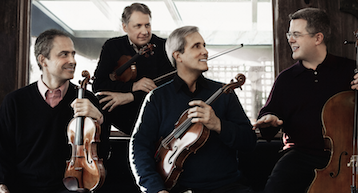by Neil McCalmont

Though the music paused when one of Watkins’ cello pegs slipped out of place near the beginning of Mozart’s String Quartet No. 15 in d, the ensemble recovered and continued with smooth sailing. Drucker, playing first violin, consistently brought out a yearning yet refined quality in the melodies, and each performer made his instrument sing its music, overcoming the dull acoustics of the hall. Dutton’s interpretation of the fourth-movement viola solo was particularly songful.
Turnage’s Shroud begins with the long, intense Threnody, featuring a cello line captivatingly played by Watkins, who lulled you like a siren into the composer’s somber sound world. The music continues to build, arriving briefly at a homophonic section that contrasts the previous dissonance in a way that was both striking and thrilling — Turnage completely turns the texture on its head. The movement journeys through moments that brought to mind Rite of Spring and the Bartók quartets, and ends with beautiful delicateness.
The second and fourth movements of Shroud are titled Intermezzo 1 and 2. The former contains fragmentary motifs and pizzicatos passed among instruments, as if the music is having an argument with itself. The players thrived, displaying their precision while brilliantly balancing between the two textures. The latter intermezzo mimics a Hungarian folk dance, making you want to get up and move.
Pulsating pizzicatos pervade throughout the third movement, March, while slides swing from violin to violin — you could see the smiles on the musicians’ faces and hear the smiles in their playing, too. The finale, Lament, returns to the work’s opening mournful mood with spine-tingling leaps, and finishes on a sumptuously rich chord. The performance was a perfect marriage of great music and great players. The audience offered their appreciation for performers and composer alike with a lengthy ovation.
Beethoven’s favorite of his string quartets, No. 14 in c#, Op. 131, ended the evening’s entertainment. From the beginning, the Emerson created a unique and convincing blend of sound. Their crystalline clarity, echoing the Classical era, was combined with a Romantic emotional directness which brought the dramatic fire found only in the rarest of performances. Setzer, here on first violin, played with an especially rich tone.
The quartet painted a deep emotional canvas out of the score of this masterpiece. They played as one voice during the sorrowful opening fugue, transitioning with a brilliant accelerando to the rollicking second movement. Capturing the humor and innocence of the lengthy theme and variations, the bubbliness of the fifth movement, and even the heart-on-the-sleeve emotionality of the finale, the Emerson provided an unforgettable end to an unforgettable night.
Published on ClevelandClassical.com October 3, 2016.
Click here for a printable copy of this article

